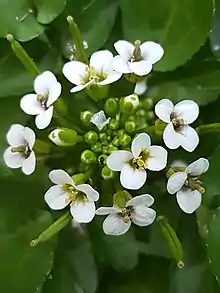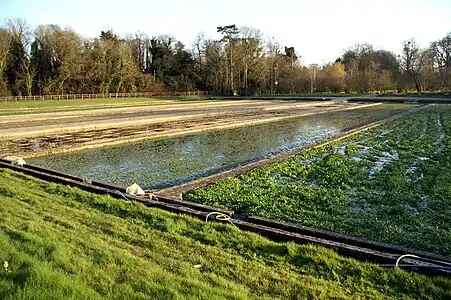Watercress
Watercress or yellowcress (Nasturtium officinale) is a species of aquatic flowering plant in the cabbage family Brassicaceae.
| Watercress | |
|---|---|
.JPG.webp) | |
| Leaves | |
 | |
| Flowers | |
| Scientific classification | |
| Kingdom: | Plantae |
| Clade: | Tracheophytes |
| Clade: | Angiosperms |
| Clade: | Eudicots |
| Clade: | Rosids |
| Order: | Brassicales |
| Family: | Brassicaceae |
| Genus: | Nasturtium |
| Species: | N. officinale |
| Binomial name | |
| Nasturtium officinale | |
| Synonyms[2] | |
|
Synonymy
| |
Watercress is a rapidly growing perennial plant native to Europe and Asia. It is one of the oldest known leaf vegetables consumed by humans. Watercress and many of its relatives, such as garden cress, mustard, radish, and wasabi, are noteworthy for their piquant flavors.
The hollow stems of watercress float in water. The leaf structure is pinnately compound. Small, white, and green inflorescences are produced in clusters and are frequently visited by insects, especially hoverflies, such as Eristalis flies.[3]
Taxonomy
Watercress is listed in some sources as belonging to the genus Rorippa, although molecular evidence shows those aquatic species with hollow stems are more closely related to Cardamine than Rorippa.[4] Despite the Latin name, watercress is not particularly closely related to the flowers popularly known as nasturtiums (Tropaeolum majus). T. majus belongs to the family Tropaeolaceae, a sister taxon to the Brassicaceae within the order Brassicales.[5]
Distribution
In some regions, watercress is regarded as a weed,[6] in other regions as an aquatic vegetable or herb. Watercress has grown in many temperate locations worldwide.[7]
British Isles
Clear fast-flowing chalk streams are the primary natural habitat for wild watercress in the British Isles. [lower-alpha 1] [lower-alpha 2] Many settlements in England were named from Old English êacerse (êa..cerse) " water−cress ".[lower-alpha 3] [lower-alpha 5]
In the United Kingdom, watercress was first commercially cultivated in 1808 by the horticulturist William Bradbery along the River Ebbsfleet in Kent. Historically important areas of cultivation also included Hampshire,[lower-alpha 6] Stamford, Lincolnshire,[lower-alpha 7] and St Albans, Hertfordshire.[lower-alpha 8]
Watercress is now grown in several counties of the United Kingdom, most notably Hampshire, Dorset, Wiltshire, and Hertfordshire. The town of Alresford, near Winchester, is considered to be the nation's watercress capital.[11]
Uses
Watercress leaves, stems, and fruit can be eaten raw.[12] Cultivated watercress has the advantage of being free of the liver fluke, Fasciola hepatica. [lower-alpha 9] [lower-alpha 10]
Tradition
Ancient Romans thought eating it would cure mental illness.[13] Twelfth-century mystic Hildegard of Bingen thought eating it steamed and drinking the water would cure jaundice or fever.[13] Watercress was eaten by Native Americans.[14] Some Native Americans used it to treat kidney illnesses and constipation, and it was thought by some to be an aphrodisiac.[13] Early African Americans used the plant as an abortifacient; it was believed to cause sterility as well.[13]
Nutrition
| Nutritional value per 100 g (3.5 oz) | |
|---|---|
| Energy | 46 kJ (11 kcal) |
1.29 g | |
| Sugars | 0.2 g |
| Dietary fiber | 0.5 g |
0.1 g | |
2.3 g | |
| Vitamins | Quantity %DV† |
| Vitamin A equiv. | 20% 160 μg18% 1914 μg5767 μg |
| Thiamine (B1) | 8% 0.09 mg |
| Riboflavin (B2) | 10% 0.12 mg |
| Pantothenic acid (B5) | 6% 0.31 mg |
| Vitamin B6 | 10% 0.129 mg |
| Folate (B9) | 2% 9 μg |
| Vitamin C | 52% 43 mg |
| Vitamin E | 7% 1 mg |
| Vitamin K | 238% 250 μg |
| Minerals | Quantity %DV† |
| Calcium | 12% 120 mg |
| Iron | 2% 0.2 mg |
| Magnesium | 6% 21 mg |
| Manganese | 12% 0.244 mg |
| Phosphorus | 9% 60 mg |
| Potassium | 7% 330 mg |
| Sodium | 3% 41 mg |
| Other constituents | Quantity |
| Water | 95 g |
| |
| †Percentages are roughly approximated using US recommendations for adults. Source: USDA FoodData Central | |
The new tips of watercress leaves can be eaten raw or cooked,[15] although caution should be used when collecting these in the wild because of parasites such as giardia.[16] Watercress is 95% water and has low contents of carbohydrates, protein, fat, and dietary fiber. A 100-gram serving of raw watercress provides 46 kilojoules (11 kilocalories), is particularly rich in vitamin K (238% of the Daily Value, DV), and contains significant amounts of vitamin A, vitamin C, riboflavin, vitamin B6, calcium, and manganese (table).
Phytochemicals and cooking
As a cruciferous vegetable, watercress contains isothiocyanates that are partly destroyed by boiling*, while the bioavailability of its carotenoids is slightly increased by cooking. *Steaming or microwave cooking retains these phytochemicals a bit better than boiling.[17]
Cultivation
Watercress cultivation is practical on both a large scale and a garden scale. Being semi-aquatic, watercress is well-suited to hydroponic cultivation, thriving best in water that is slightly alkaline. It is frequently produced around the headwaters of chalk streams. In many local markets, the demand for hydroponically grown watercress exceeds supply, partly because cress leaves are unsuitable for distribution in dried form and can only be stored fresh for about 2–3 days.[18]
Also sold as sprouts, the edible shoots are harvested days after germination. If unharvested, watercress can grow to a height of 50 to 120 centimetres (1 ft 8 in to 3 ft 11 in).
Concerns
Watercress crops grown in the presence of manure can be an environment for parasites such as the liver fluke, Fasciola hepatica.[19]
By inhibiting the cytochrome P450 enzyme CYP2E1, compounds in watercress may alter drug metabolism in individuals on certain medications such as chlorzoxazone.[20]
Due to its fast-growing nature and invasive species status, Nasturtium officinale is prohibited in Illinois.[21]
See also
- Fool's watercress – Apium nodiflorum
- Garden cress
- List of vegetables
- Watercress soup
References
Notes
- Flora Britannica ( Richard Mabey ). . .Water-cress was traditionally picked wild from the edges of fast-flowing streams, where it can grow in thick drifts. . .by the 19th century it was certainly under small-scale cultivation, especially in areas where there were clear chalk streams, such as Wiltshire and the north Chilterns. . .[8]
- See Chalk streams > Ecology > Many of the chalk stream springs are also used as sites for watercress production, due to the constant temperature and clean, alkaline, mineral-rich spring water.
- Old English êacerse, " water−cress ". . .[9]
- WiKtionary : English < haugh > " A low-lying meadow by the side of a river. "
- Flora Britannica ( Richard Mabey ).[8] . .Water-cress. . .It was important enough for settlements to be named after it. . .Examples:
- Kersey, Suffolk, "cress island".
- Kesgrave, Suffolk, "ditch or grove where cress grows".
- Kersal, Lancashire, "the haugh[lower-alpha 4] where cress grows".
- Kershopefoot, Cumbria, "cress valley".
- See Watercress Line
- Flora Britannica ( Richard Mabey ). . .Special railway tracks – " Watercress lines " – were established to run the crop up to London and are still referred to by this name in north Hampshire and near Stamford in Lincolnshire. . .[10]
- See Watercress Wildlife Site
- Flora Britannica ( Richard Mabey ). . .Water-cress. . .often contaminated in the wild by liver-fluke larvae. . .cooking kills all stages of the fluke. . .Water-cress grown commercially in beds has the advantage. . .of growing in water drawn directly from underground springs or bore-holes. . .[10]
- See (Contents) > Uses > Concerns . . .liver fluke.
Citations
- Ghogue, J.-P.; Akhani, H. & Zehzad, B. (2020). "Nasturtium officinale". IUCN Red List of Threatened Species. 2020: e.T164311A136666515. Retrieved 21 May 2022.
- The Plant List, Nasturtium officinale R.Br.
- Van Der Kooi, C. J.; Pen, I.; Staal, M.; Stavenga, D. G.; Elzenga, J. T. M. (2016). "Competition for pollinators and intra-communal spectral dissimilarity of flowers" (PDF). Plant Biology. 18 (1): 56–62. doi:10.1111/plb.12328. PMID 25754608.
- Al-Shehbaz, Ihsan A.; Price, Robert A. (1998). "Delimitation of the Genus Nasturtium (Brassicaceae)". Novon. 8 (2): 124–6. doi:10.2307/3391978. JSTOR 3391978.
- Fay, Michael F.; Christenhusz, Maarten J.M. (14 September 2010). "Brassicales - an Order of Plants Characterised by Shared Chemistry". Curtis's Botanical Magazine. 27 (3): 165–196. doi:10.1111/j.1467-8748.2010.01695.x.
- "Washington State Noxious Weed Control Board". www.nwcb.wa.gov. Retrieved 4 May 2021.
- "Watercress". www.fs.fed.us. Retrieved 4 May 2021.
- Mabey 1996, p. 147.
- Clark Hall 1916, p. 182.
- Mabey 1996, p. 148.
- Peters, Rick (30 March 2010). "Seasonal food: watercress". The Guardian. Retrieved 15 December 2012.
- Benoliel, Doug (2011). Northwest Foraging: The Classic Guide to Edible Plants of the Pacific Northwest (Rev. and updated ed.). Seattle, WA: Skipstone. p. 161. ISBN 978-1-59485-366-1. OCLC 668195076.
- Lyle, Katie Letcher (2010) [2004]. The Complete Guide to Edible Wild Plants, Mushrooms, Fruits, and Nuts: How to Find, Identify, and Cook Them (2nd ed.). Guilford, CN: FalconGuides. pp. 34–35. ISBN 978-1-59921-887-8. OCLC 560560606.
- Nyerges, Christopher (2017). Foraging Washington: Finding, Identifying, and Preparing Edible Wild Foods. Guilford, CT: Falcon Guides. ISBN 978-1-4930-2534-3. OCLC 965922681.
- Nyerges, Christopher (2016). Foraging Wild Edible Plants of North America: More than 150 Delicious Recipes Using Nature's Edibles. Rowman & Littlefield. ISBN 978-1-4930-1499-6.
- Blackwell, Laird R. (2006). Great Basin Wildflowers: A Guide to Common Wildflowers of the High Deserts of Nevada, Utah, and Oregon (A Falcon Guide) (1st ed.). Guilford, Conn.: Morris Book Publishing, LLC. p. 196. ISBN 0-7627-3805-7. OCLC 61461560.
- Giallourou, Natasa; Oruna-Concha, Maria Jose; Harbourne, Niamh (1 November 2016). "Effects of domestic processing methods on the phytochemical content of watercress (Nasturtium officinale)" (PDF). Food Chemistry. 212: 411–419. doi:10.1016/j.foodchem.2016.05.190. ISSN 0308-8146. PMID 27374550.
- "How Long Does Fresh Watercress Last?". www.stilltasty.com. Retrieved 16 June 2022.
- "DPDx - Laboratory Identification of Parasitic Diseases of Public Health Concern: Fascioliasis". US Centers for Disease Control. 29 November 2013.
- Leclercq, Isabelle; Desager, Jean-Pierre; Horsmans, Yves (1998). "Inhibition of chlorzoxazone metabolism, a clinical probe for CYP2E1, by a single ingestion of watercress". Clinical Pharmacology & Therapeutics. 64 (2): 144–9. doi:10.1016/S0009-9236(98)90147-3. PMID 9728894. S2CID 43863786.
- Cao L, Berent L (30 July 2019). "Nasturtium officinale W.T. Aiton". U.S. Geological Survey. Retrieved 15 June 2022.
Sources
- Mabey, Richard (1996). Flora Britannica. Sinclair-Stevenson. ISBN 1-85619-377-2.
- Clark Hall, John Richard (1916). A Concise Anglo−Saxon Dictionary, Second Edition. The Macmillan Company.

